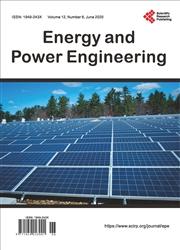Solution of Combined Heat and Power Economic Dispatch Problem Using Genetic Algorithm
引用次数: 0
Abstract
This research proposes a synergistic meta-heuristic algorithm for solving the extreme operational complications of combined heat and power economic dispatch problem towards the advantageous economic outcomes on the cost of generation. The combined heat and power (CHP) is a system that provides electricity and thermal energy concurrently. For its extraordinary efficiency and significant emission reduction, it is considered a promising energy pros-pect. The broad application of combined heat and power units requires the joint dispatch of power and heating systems, in which the modelling of combined heat and power units plays a vital role. The present research employs the genetic optimization algorithm to evaluate the cost function, heat and power dispatch values encountered in a system with simple cycle cogeneration unit and quadratic cost function. The system was first modeled to determine the various parameters of combined heat and power units towards solving its economic dispatch problem directly. In order for modelling to be done, a general structure of combined heat and power must be defined. The test system considered consists of four units: two conventional power units, one combined heat and power unit and one heat-only unit. The algorithm was applied to test system while taking into account the power and heat units, bounds of the units and feasible operation region of cogeneration unit. Output decision variables of 4-unit test systems plus cost function from Genetic Algorithm (GA), was determined using appropriate codes. The proposed algorithm obtained compared favourably with that obtained with the direct solution algorithm discussed in a previous paper. We conclude that the genetic algorithm is quite efficient in dealing with non-convex and constrained combined heat and power economic dispatch problem.用遗传算法求解热电联产经济调度问题
针对热电联产经济调度问题的极端运行复杂性,提出了一种协同启发式算法,以获得对发电成本有利的经济结果。热电联产(CHP)是一种同时提供电能和热能的系统。由于其非凡的效率和显著的减排,它被认为是一个有前途的能源前景。热电联产机组的广泛应用要求电、热联合调度,其中热电联产机组的建模起着至关重要的作用。本研究采用遗传优化算法对具有简单循环热电联产机组和二次成本函数的系统的成本函数、热电调度值进行求解。首先对系统进行建模,以确定热电联产机组的各项参数,直接解决热电联产机组的经济调度问题。为了进行建模,必须确定热电联产的一般结构。所考虑的测试系统由四个单元组成:两个常规动力单元,一个热电联产单元和一个单热单元。将该算法应用于测试系统,同时考虑了热电联产机组的功率和热量单元、机组边界和可行运行区域。使用适当的代码确定4单元测试系统的输出决策变量加上遗传算法(GA)的成本函数。该算法的结果与前人讨论的直接解算法的结果相比,具有较好的优越性。研究结果表明,遗传算法在求解非凸约束的热电联产经济调度问题上是非常有效的。
本文章由计算机程序翻译,如有差异,请以英文原文为准。
求助全文
约1分钟内获得全文
求助全文

 求助内容:
求助内容: 应助结果提醒方式:
应助结果提醒方式:


